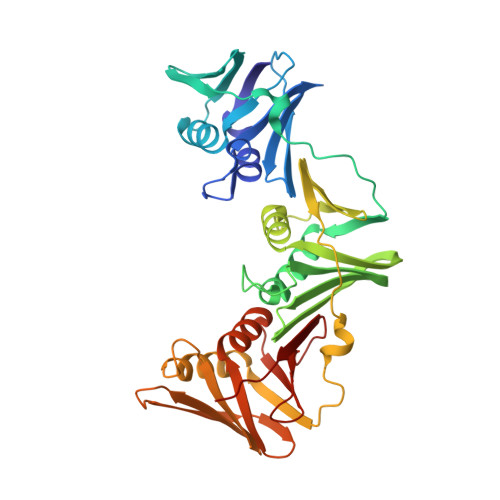Sliding clamp-DNA interactions are required for viability and contribute to DNA polymerase management in Escherichia coli.
Heltzel, J.M., Scouten Ponticelli, S.K., Sanders, L.H., Duzen, J.M., Cody, V., Pace, J., Snell, E.H., Sutton, M.D.(2009) J Mol Biology 387: 74-91
- PubMed: 19361435
- DOI: https://doi.org/10.1016/j.jmb.2009.01.050
- Primary Citation of Related Structures:
3F1V - PubMed Abstract:
Sliding clamp proteins topologically encircle DNA and play vital roles in coordinating the actions of various DNA replication, repair, and damage tolerance proteins. At least three distinct surfaces of the Escherichia coli beta clamp interact physically with the DNA that it topologically encircles. We utilized mutant beta clamp proteins bearing G66E and G174A substitutions (beta159), affecting the single-stranded DNA-binding region, or poly-Ala substitutions in place of residues 148-HQDVR-152 (beta(148-152)), affecting the double-stranded DNA binding region, to determine the biological relevance of clamp-DNA interactions. As part of this work, we solved the X-ray crystal structure of beta(148-152), which verified that the poly-Ala substitutions failed to significantly alter the tertiary structure of the clamp. Based on functional assays, both beta159 and beta(148-152) were impaired for loading and retention on a linear primed DNA in vitro. In the case of beta(148-152), this defect was not due to altered interactions with the DnaX clamp loader, but rather was the result of impaired beta(148-152)-DNA interactions. Once loaded, beta(148-152) was proficient for DNA polymerase III (Pol III) replication in vitro. In contrast, beta(148-152) was severely impaired for Pol II and Pol IV replication and was similarly impaired for direct physical interactions with these Pols. Despite its ability to support Pol III replication in vitro, beta(148-152) was unable to support viability of E. coli. Nevertheless, physiological levels of beta(148-152) expressed from a plasmid efficiently complemented the temperature-sensitive growth phenotype of a strain expressing beta159 (dnaN159), provided that Pol II and Pol IV were inactivated. Although this strain was impaired for Pol V-dependent mutagenesis, inactivation of Pol II and Pol IV restored the Pol V mutator phenotype. Taken together, these results support a model in which a sophisticated combination of competitive clamp-DNA, clamp-partner, and partner-DNA interactions serve to manage the actions of the different E. coli Pols in vivo.
- Department of Biochemistry, School of Medicine and Biomedical Sciences, University at Buffalo, State University of New York, Buffalo, NY 14214, USA.
Organizational Affiliation:


















